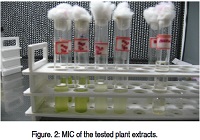Medicinal Plants on Acne inducing Bacteria
Keywords:
Acne, Acne vulgaris, MIC, MBCAbstract
Acne is a cutaneous pleomorphic disorder of the pilosebaceous unit involving abnormalities in sebum production and is characterized by both inflammatory (papules, pustules and nodules) and non-inflammatory (comedons, open and closed) lesions. Propionibacterium acnes and Staphylococcus epidermidis are common pus-forming microbes responsible for the development of various forms of Acne vulgaris. The present study was conducted to evaluate antimicrobial activities of seven medicinal plants against acne-inducing bacteria. Acetonic and aqueous extracts of Azadirachta indica (leaves), Curcuma longa (root), Aloe vera (leaves), Withania somnifera (leaves), Terminalia arjuna (bark), Ocimim sanctum (leaves), Santalum album (wood) were tested for antimicrobial activities by agar diffusion, Minimum Inhibitory Concentration (MIC) and Minimum Bactericidal Concentration (MBC) methods. The results from the agar diffusion method showed that five medicinal plants could inhibit the growth of acne-inducing bacteria. Among these Azadirachta indica, Curcuma longa and Terminalia arjuna had strong inhibitory effects. Based on MIC, the acetonic extracts of Azadirachta indica and Curcuma longa had the greatest antimicrobial effects. Taken together, the present study indicated that Azadirachta indica had a strong inhibitory effect on acne-inducing bacteria.
References
. Ayres S. Jr, and Mihan R. Acne
vulgaris: therapy directed at
pathophysiologic defects. International
Journal of Dermatology, 1981. 20:616.
DOI: 10.1111/j.1365-
1981.tb00849.x
. Bojar RA, Eady EA, Jones CE, Cunliffe
WJ and Holland KT. Inhibition of
erythromycin-resistant propionibacteria
on the skin of acne patients by topical
erythromycin with and without zinc.
British Journal of Dermatology, 1994.
:329. DOI: 10.1111/j.1365-
1994.tb02929.x
. Darley CR, Moore JW, Besser GM,
Munro DD, Edwards CR, Rees LH and
Kirby JD. Androgen status in women
with late onset or persistent acne
vulgaris. Clinical and Experimental
Dermatology, 1984. 9:28. DOI:
1111/j.1365-2230.1984.tb00751
. Epstein M. The growing role of calcium
antagonists in treating hypertension in
the elderly. The American Journal of
Geriatric Cardiology, 2000. 9:42-48
DOI: 10.1111/j.1076-
2000.80007.x
. Ghosh V K. Different approaches of
alternative medicines in acne vulgaris
treatment. Orient Pharm Exp. Med; et
al., 2011 ,11:1-9 DOI:
1007/s13596.011.0006-6.
. Jacobs DG, Deutsch NL and Brewer
M. Suicide, depression, and
isotretinoin: is there a causal link? J
Am Acad Dermatol; 2001.45:S168-
S175. DOI: 10.1067/mjd.2001.118233
. Klassen AF, Newton JN and Mallon E.
Measuring quality of life in people
referred for specialist care of acne:
Comparing generic and diseasespecific measures. J AM Acad
Dermatol; 2000. 43:229-33. DOI:
1067/mjd.2000.105507
. Kligman AM, Jr. Mills OH, Leyden JJ,
Gross PR. Allen HB and Rudolph RI.
Oral vitamin A in acne vulgaris.
Preliminary report. International Journal
of Dermatology, 1981.20:278-285 DOI:
1111/j.1365-4362.1981.tb04338.x.
. Koo JY and Smith LL. Psychologic
Aspects of Acne. Ped Dermatol
;8:185-8. DOI: 10.1111/j.1525-
1991.tb00856.x
. Krowchuk DP, Stancin T, Keskinen R,
Walker R, Bass J and Anglin TM.. The
psychosocial effects of acne in
adolescents. Pediatric Dermatol, 1991.
:332-8. DOI: 10.1111/j.1525-
1991.tb00945.x
. Lasek RJ. and Chren MM. Acne
Vulgaris and the Quality of Life of Adult
Dermatology Patients. Arch Derm,
134:454-8. DOI:
1001/archderm.134.4.454
. McCarty, M., 1984. High-chromium
yeast for acne? Medical Hypotheses,
:307-310 DOI: 10.1016/0306-
(87)90134-4
. Michaelsson G, Juhlin L. and Vahlquist
A. Effects of oral zinc and vitamin A in
acne. Arch derm 1977a.113:31-36 DOI:
1001/archderm.113.1.31
. Michaelsson G, Vahlquist A and Juhlin
L. Serum zinc and retinol-binding
protein in acne. Br J Dermatol, 1977b.
:283. DOI: 10.1111/j.1365-
1977.tb06138.x
. Michaelsson G, Juhlin L. and Ljunghall
K. A double-blind study of the effect of
zinc and oxytetracycline in acne
vulgaris . Br J Dermatol, 1977c.
:561. DOI: 10.111/j.1365-
1977.tb14136.x
. Nand P, Drabu S, Gupta RK,
Insignificant anti-acne activity of
Azadirachta indica leaves and bark. J
Pharm negative results. 2012. 3: 29-33.
. Newton JN, Mallon E, Klassen A, Ryan
TJ and Finlay AY. The effectiveness of
acne treatment: an assessment by
patients of the outcome of therapy. Br J
Dermatol 1997.137: 563-7. DOI:
1111/j.1365-2133.1997.tb03787.x
. Paraskevaidis A, Drakoulis N, Roots I,
Orfanos CE and Zouboulis
CC.,Polymorphisms in the human
cytochrome P-450 1A1 gene (CYP1A1)
as a factor for developing acne.
Derematology, 1998. 196:171. DOI:
1159/000017855
. Randle HW, Diaz-Perez JL and
Winkelmann RK. Toxic doses of
vitamin A for pityriasis rubra pilaris.
Arch Derm, 1980.116:888. DOI:
1001/archderm.1980.01640320038
. Rubinow DR, Peck GL, Squillace KM
and Gantt GG. Reduced anxiety and
depression in cystic acne patients after
successful treatment with oral
isotretinoin. J Am Acad Dermatol,
17:25-32. DOI: 10.1016/s0190-
(87)70166-2
. Ruiz-Maldonado R, Tamayo-Sanchez
L.and de La Luz Orozco-Covarrubias
M. The use of retinoids in the pediatric
patient. Dermatologic Clinics, 1998.
:553. DOI: 10.1016/s0733-
(05)70252-7
. Sansone G. and Reisner RM.
Differential rates of conversion of
testosterone to dihydrotestosterone in
acne and in normal human skin--a
possible pathogenic factor in acne.
Journal of Investigative Dermatology,
56:366. DOI: 10.1111/1523-
ep12261252
. Schiavone FE, Rietschel RL, Sgoutas
D and Harris R. Elevated free
testosterone levels in women with
acne. Arch Derm, 1983. 119:799. DOI:
1001/archderm.119.10.799
. Sunday E. Atawadi and Joy C.
Atawadi. Phytochem Rev. 2009.8:601-
DOI: 10.1007/s11101-00909144-
. Symes EK, Bender DA, Bowden JF
and Coulson WF. Increased target
tissue uptake of, and sensitivity to,
testosterone in the vitamin B6 deficient
rat. Journal of Steroid Biochemistry,
20:1089. DOI: 10.1016/0022-
(84) 90348-0
. Takayasus S, Wakimoto H, Itami S and
Sano S. Activity of testosterone 5
alpha-reductase in various tissues of
human skin. Journal of Investigative
Dermatology, 1980. 74:187. DOI:
1111/1523-1747.ep12541698
. Tan JK, Vasey K and Fung KY. Beliefs
and Perceptions of patients with acne.
J AM Acad Dermatol, 2001. 44:439-45.
DOI: 10.1067/mjd.2001.111340
. Thomas JR, Cooke JP and
Winkelmann RK. High-dose vitamin A
therapy for Darier's disease. Arch
Derm, 1982.118:891. DOI:
1001/archderm.118.11.891
. Tschesche R. Advances in the
chemistry of antibiotics substances
from higher plants: Pharmacognosy
and phytochemistry. Springer-Verlag,
Berlin Heidelberg, New York:
274-289. DOI: 10.1007/978-3-
-65136-6_12
. Weimar VM, Puhl SC, Smith WH and
Broeke JET. Zinc sulfate in acne
vulgaris. Arch Derm, 1978.114:1776.
DOI:
1001/archderm.1978.01640240018



